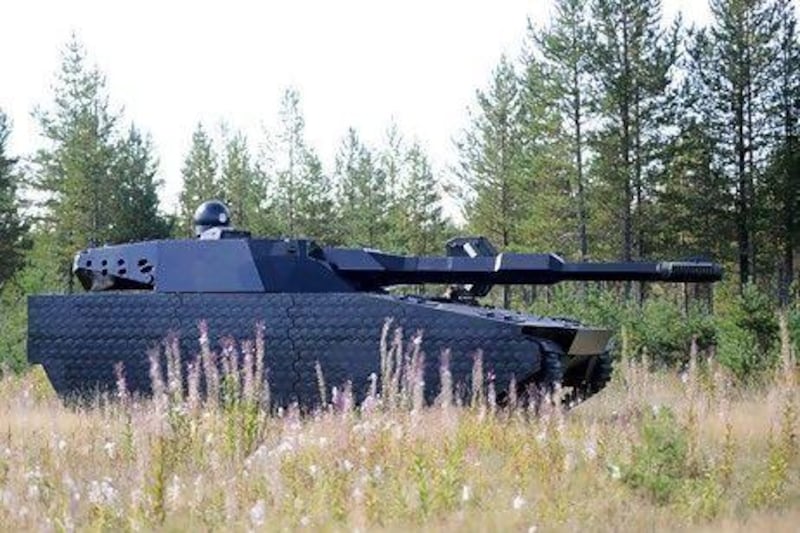From Harry Potter's invisibility cloak to Wonder Woman's transparent jet, the idea of making something disappear to evade detection has long been the stuff of fantasy.
Defense The latest in military tech
Stealth aircraft The US, Russia and China have all used aircraft using stealth technology to avoid detection through a combination of features ranging from radar-jamming equipment to the latest designs and materials.
Stealth submarines Scientists are developing plans to enable submarines to glide through the water without creating a wake that can be detected, by channelling water around the craft.
Liquid body armour Lightweight and flexible, the technology uses Kevlar, a strong material, to spread the impact of a bullet or piece of shrapnel over a large surface area.
But now BAE Systems, the UK defence company, has brought science fiction a step closer to science fact. In a groundbreaking project, BAE has developed an "invisibility cloak" that allows a tank to avoid infrared detection by blending into the surroundings.
Armed with electronic cameras along the vehicle, the system records images of the immediate environment and then projects them on to panels on the outside of the tank.
As a result, the vehicle appears to merge into the landscape to avoid detection - even during the day.
One side of a tank can appear invisible down to a range of between 400 or 500 metres. Alternatively, the cameras can display stored images to make a tank look like another object such as a 4x4 vehicle or even a cow.
Scientists say the technology will be ready to produce within two years and could signal a breakthrough in the way warfare is waged. The system, they say, should give a clear advantage over enemy forces.
"Earlier attempts at similar cloaking devices have hit problems because of cost, excessive power requirements or because they were insufficiently robust," says Peter Sjolund, a project manager at BAE.
"Our panels can be made so strong that they provide useful armour protection and consume relatively low levels of electricity, especially when the vehicle is at rest in 'stealth recce' mode and generator output is low."
But analysts question the cost-effectiveness of the technology and the scale of demand at a time when defence budgets around the world are being cut.
The US, the biggest military spender, is preparing to make US$350 billion (Dh1.28 trillion) in defence cuts during the next decade as it scales down its involvement in Afghanistan and Iraq.
With the world's only superpower creaking under $13tn of debt, military spending is expected to be squeezed for years to come.
Other western countries are following suit. Britain, France and other European nations are also pushing ahead with defence reductions as they seek to reduce spiralling public debt.
"Money is tight at the moment," says Endre Lunde, a defence consultant at IHS Janes, a defence advisory company. "I have my doubts that this technology could be applied across a fleet in a cost-effective manner."
But BAE insists there is already interest in the patented technology, known as Adaptiv. The Swedish defence ministry funded half the project and the technology has already been successfully tested on combat vehicle tanks in Sweden in July.
Now BAE is looking to market it further afield.
"We have a global focus but the Middle East is part of that," says Mike Sweeney, a spokesman for BAE. "It might well be that Middle East terrain is particularly suitable to the system as a lot of conflict takes place at longer distance in desert terrain."
The UAE and Saudi Arabia, along with other emerging markets such as India and Brazil, are keen to invest in the latest military equipment.
The four nations are expected to add $30bn during the next five years to existing defence budgets, according to Jane'sDefence Weekly publication.
But BAE admits that hot Middle East climates could prove a challenge. It has not yet been tested in such conditions.
Extreme heat could affect the technology, which is based on sheets of hexagonal pixels that can change temperature, turning the side of the tank into an infrared screen. Equally, Arctic conditions could also pose a challenge.
Still, Mr Sweeney believes the technology can be adapted, and scientists intend to insert special materials into the pixels at a future date to avoid detection by radar. They are also pushing ahead to develop the ultimate goal - complete invisibility.
"We can resize the pixels to achieve stealth for different ranges," says Mr Sjolund. "A warship or building, for instance, might not need close-up stealth so could be fitted with larger panels."
The development of so-called e-camouflage could spell the beginning of the end for conventional methods used to avoid enemy detection such as paint and netting. The Adaptiv technology would change in tandem with the environment, helping the vehicle to always appear invisible.
Traditional camouflage is less adaptable. For example, in Afghanistan's Helmand province, all British army vehicles have desert sand-coloured camouflage, which is less useful in the nearby Green Zone, an area of different terrain where crops are cultivated.
In contrast, BAE Systems hopes its technology could help to usher in a new era in military disguise.
"This technology is a question of showing what can be done in the longer term," says Mr Lunde.





